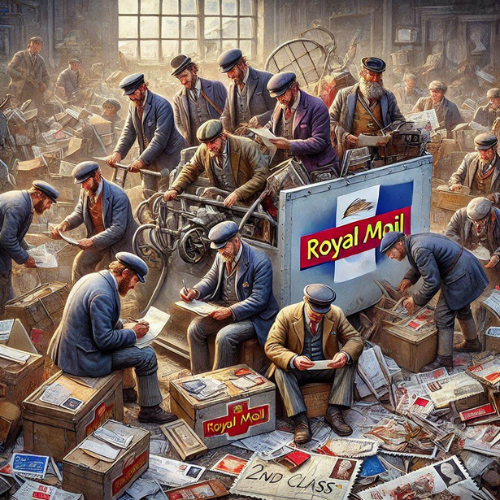Royal Mail is preparing to roll out significant changes to its operations, marking a pivotal moment in its history. Among the most notable adjustments is the consideration of Royal Mail scrapping 2nd Class post on Saturdays which is set to impact nearly one million households in 2024. These changes are part of a broader strategy to modernise the postal service and adapt to evolving customer demands and financial pressures.
This development reflects Royal Mail’s efforts to balance operational efficiency with maintaining its commitment to reliable service. The decision comes in response to declining letter volumes and the growing prominence of parcel deliveries, driven by online shopping. By focusing on streamlining services, Royal Mail aims to remain competitive while addressing the challenges of its Universal Service Obligation (USO).
What Does Scrapping 2nd Class Post Mean?
Starting in February 2024, Royal Mail will initiate a trial period to reduce second-class deliveries in select areas. This pilot programme will involve 37 of its 1,200 delivery offices, with an estimated one million homes affected during the trial phase. The primary goal is to test the feasibility of discontinuing Saturday deliveries for second-class post, paving the way for potential long-term changes.
Although the exact locations for the trial remain undisclosed, Royal Mail has assured an even geographical distribution, with three delivery offices chosen from each UK region. This approach ensures a comprehensive assessment of the changes’ impact across diverse areas.
It’s important to note that the trial will not affect other key services. Customers can continue to rely on Royal Mail tracked service options, first-class post, and parcel deliveries, all of which will remain available six days a week. This decision underscores Royal Mail’s commitment to meeting the needs of customers who require faster or more secure postal options.
The scrapping of Saturday second-class post is not just a logistical adjustment; it signals a significant shift in Royal Mail’s operational priorities. Second-class post has long been a cost-effective solution for budget-conscious customers, offering an economical way to send letters and parcels. By trialling this reduction, Royal Mail is responding to a changing postal landscape while seeking ways to optimise resources and reduce costs.
This trial is part of a broader conversation about the future of postal services in the UK. With Ofcom set to consult on potential changes to the USO, including reducing letter deliveries to five days a week, Royal Mail is positioning itself to adapt to these forthcoming regulatory developments.

Why Is Royal Mail Making These Changes?
Royal Mail’s commitment to delivering letters six days a week under the Universal Service Obligation (USO) has become financially unsustainable. The company estimates that maintaining this service costs up to £2 million daily.
Additionally, there has been a sharp decline in letter volumes over the years, dropping from 20 billion annually in 2004/05 to just 6.7 billion today. In response, Royal Mail has been lobbying for a more flexible approach to the USO for the past four years.
Impact on Customers
The planned changes to the services, particularly Royal Mail scrapping 2nd Class post on Saturdays, are likely to have a noticeable impact on customers. Second-class post has long been valued for its affordability and accessibility, especially for those who prioritise cost savings over speed. The current Royal Mail 2nd Class price structure provides a range of economical options for sending letters and parcels, ensuring this service remains a go-to choice for many households and businesses.
Affordability and Practicality
Royal Mail’s 2nd Class service is a cornerstone of its offerings, delivering a balance of low-cost postage with reasonable delivery times. For instance, second-class postage prices for letters start at just 85p, while larger items like parcels can be sent for as little as £3.75, depending on size and weight. This makes it an attractive option for individuals and small businesses looking to minimise expenses without sacrificing reliability.
For those sending everyday items like letters, magazines, or lightweight parcels, the service provides a practical and cost-effective solution. It’s particularly popular for non-urgent deliveries, ensuring items reach their destination within two to three working days, including Saturdays under the current framework.
Limitations of Second-Class Post
While affordable, second-class post does come with certain limitations. One of the most notable is the lack of tracking. Unlike the Royal Mail tracked service, second-class deliveries do not include real-time monitoring, which can make it less suitable for sending valuable or time-sensitive items.
However, this doesn’t mean senders are left without safeguards. Every second-class item is covered by compensation of up to £20 for loss or damage. This feature provides peace of mind for customers sending low-cost, replaceable goods, such as books, documents, or inexpensive merchandise. For higher-value items, Royal Mail recommends opting for services like Special Delivery Guaranteed, which include comprehensive tracking and additional insurance.
Who Benefits Most from Second-Class Post?
The service is particularly advantageous for:
- Individuals sending personal mail: Letters, cards, and small gifts that do not require tracking are well-suited for second-class post.
- Small businesses on a budget: Entrepreneurs often rely on second-class post to send products to customers, particularly for items that are easy to replace or fall within the compensation limit.
- eBay and marketplace sellers: Many online sellers opt for second-class post to keep costs down while offering a reliable delivery option to their buyers.
Despite its limitations, second-class post remains a lifeline for those who prioritise cost-efficiency. The £20 compensation can be particularly beneficial for resolving issues without significant financial loss, making it a practical choice for sending low-value items.
Adapting to the Changes
As Royal Mail begins trialling reduced second-class post deliveries, customers may need to explore alternative options. While first-class post and Royal Mail tracked service will remain available, these options come at higher price points. Adjusting to the changes may involve weighing the cost of enhanced services against the benefits of speed and security.
For businesses and regular users of second-class post, understanding the available options and their costs will be essential to maintaining smooth operations. The trial period provides an opportunity for customers to adapt their shipping strategies while assessing how the changes may impact their needs in the long term.
Royal Mail Prices for Royal Mail 2nd Class Stamps
Royal Mail remains a cost-effective option for posting within the UK. Here is a breakdown of current Royal Mail 2nd Class price options:
Letters
- Up to 100g: £0.85
Large Letters
- Up to 100g: £1.55
- 101–250g: £2.10 (£1.90 online)
- 251–500g: £2.50 (£2.30 online)
Small Parcels
- Up to 2kg: £3.75 (£3.25 online)
Medium Parcels
- Up to 2kg: £6.15 (£4.85 online)
- 2–10kg: £7.65 (£6.35 online)
All prices are exempt from VAT.
Second-class postage also remains a popular choice for users of Royal Mail 2nd Class stamps, which provide a flexible and straightforward way to send smaller items. The Royal Mail prices are significantly lower when it comes to posting out smaller items but other services may provide a more cost effective option when sending larger items. We’d always recommend comparing parcel prices.

Ofcom Consultation and Future Outlook
Ofcom, the postal services regulator, plans to launch a consultation in early 2024 regarding the possibility of delivering second-class letters every other working day. This decision will likely shape the future of the UK’s postal service, with a final outcome expected by summer 2024. If approved, national implementation could begin as early as 2026.
Interestingly, Parliament’s approval is not required to enact these changes, making the regulatory process simpler.
Alternatives to 2nd Class Post
For senders requiring added security, the Royal Mail tracked service provides peace of mind. Tracked services ensure that items can be monitored throughout their journey, offering reliability for more valuable goods.
However, for those comfortable with slower delivery times and no tracking, second-class post remains an affordable option. One user shared their experience:
“I use second-class post for eBay sales. It’s affordable, and the £20 free compensation gives me peace of mind. For more valuable items, I switch to tracked services.”
Restricted and Prohibited Items
While Royal Mail offers flexible options, certain items cannot be sent via its services. Prohibited items include batteries, aerosols, perfumes, nail polish, and flammable substances. Always check Royal Mail’s guidelines to ensure compliance.
The Bigger Picture
The decision to trial reduced second-class deliveries reflects Royal Mail’s efforts to adapt to changing customer needs and financial realities. While some may lament the loss of Saturday second-class post, the focus on efficiency and innovation could ultimately benefit customers.
Whether you’re relying on Royal Mail 2nd Class stamps for everyday mail or exploring the benefits of the Royal Mail tracked service, the postal service continues to offer solutions for diverse needs. Keep an eye on upcoming changes to stay informed and make the most of Royal Mail’s evolving services.
